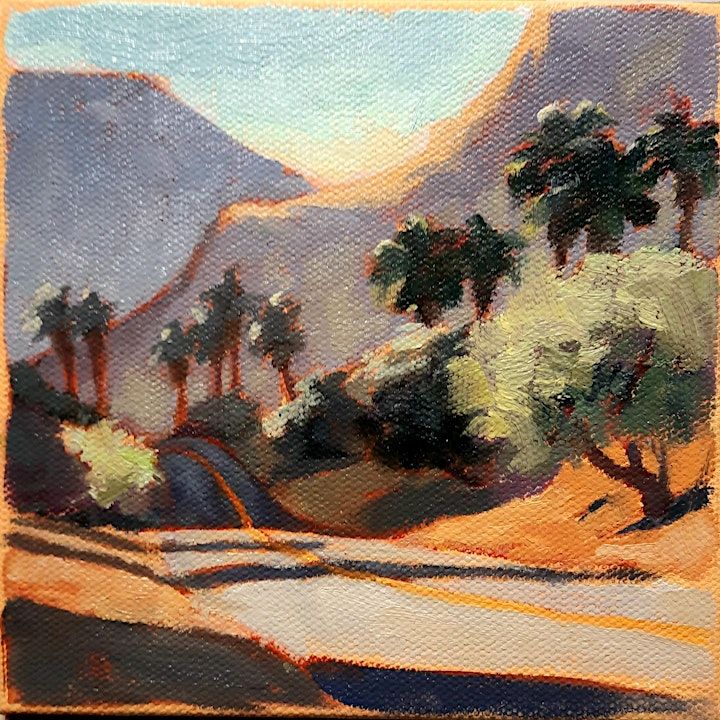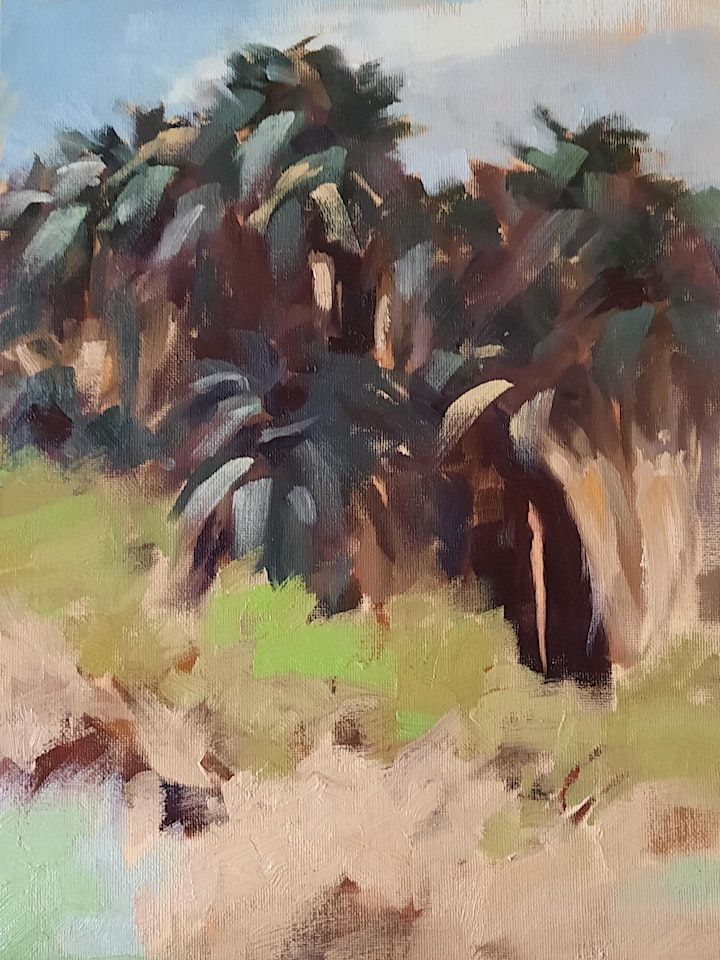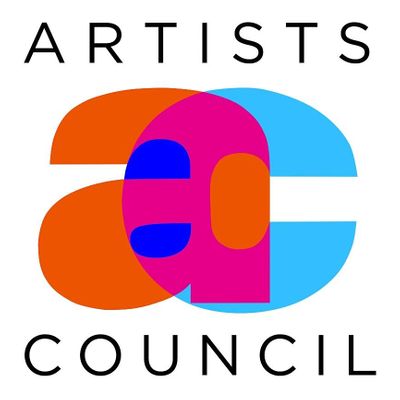One-Day Plein Air Intensive
Schedule
Sun Mar 23 2025 at 08:30 am to 03:30 pm
UTC-07:00Location
Artists Center at the Galen | Palm Desert, CA

About this Event
This workshop is useful for beginning, intermediate and advanced students. This is a 1-day Plein Air Intensive workshop which will be held outdoors at the Artist Center at the Galen. Please read the materials list carefully and come prepared.
Painting the landscape from life is thrilling and can be challenging as well. The world is filled with an infinite variety of color and value, and an overwhelming amount of detail. Patterns of shadow and light are changing each moment. This workshop will help you to simplify and organize what you see, and go on to create satisfying, dynamic paintings with strong, logical dark and light patterns.
Topics will include:
• composition,
• focal point,
• perspective and
• value (dark and light),
• color theory.
• managing oil paint (or other opaque mediums).
We will explore:
• underpainting,
• painting ala prima (layering wet paint without making mud),
• mixing paint, and more.
Morning will start with a demo painting as Jessica explains her step-by-step method. Students will be given individual feedback and guidance.
Our morning painting location will be in front of the Galen, where there is a beautiful view. After lunch we will begin another painting in a different location TBA.
MATERIALS LIST
Easel - A Julian or French easel, or a pochade box and a tripod would be the best. Or you can get by with a cheaper portable easel if you have some sort of table to put your paint on. I can loan a couple of easels if you let me know in advance.
Paint:
For Oil Paint: Gamblin is supposedly the least toxic brand. There are other brands of similar quality and price, and also higher quality, more expensive paints and cheaper low-quality brands available. Buy artist's quality, not student paint if possible. Student paints are mostly filler, very little pigment, and you will need to use so much of it that you'll probably lose money in the end. Acrylic paint is more difficult to use outdoors (but not impossible), because it dries up on the pallette and you will have to keep mixing the same colors over and over.
• Basic Colors: (all you really need) ultramarine blue, phthalo blue, cadmium red light, alizarin crimson, cadmium yellow medium, burnt sienna, yellow ochre, titanium white.
• Other Colors: *Cadmium orange (I use lots of this but of course you can mix your own orange), *Sap green (I love this transparent green and use lots of it, but you can mix your own green), *Dioxazine purple (you will use very little of this and can easily mix ultramarine blue and alizarin crimson to get purple), Phthalo green (you will use very little of this beautiful color. You can mix phthalo blue with yellow to get a bright pure green similar to this), *carbon black. (You won't be arrested if you use black, but I haven't used it for years. I mix ultramarine blue with burnt sienna, or other combinations, to make a more interesting black), *Paynes grey, A transparent blue-black. A shortcut to mixing your own black. *Quinacridone magenta. A beautiful pure pink, Nice to have but I haven't seen a need for it in the desert or Idyllwild landscape. There are hundreds of colors available. Having lots of colors will make your job harder, not easier.
• Thinner: Turpenoid or Gamsol, and a couple of small containers. (Gamsol is supposedly less toxic). (or water if you are using acrylic) Medium For oil paint: liquin or neo megilp or linseed oil. Linseed oil dries the slowest and is least toxic. Liquin dries fastest and is most toxic. I use linseed oil. (or acrylic medium if you are using acrylic paint). There are other mediums as well that I haven't tried.
• Brushes: There are lots of other choices, just make sure the bristles are stiff, not soft. Long handles are best for plein air in my opinion. I prefer synthetic brushes over natural bristle. My favorites right now are Catalyst by Princeton, brights, # 6 , 8, and 10, and Winsor Newton University Round, #2 and #1. They are all affordable synthetic brushes available from dickblick.com. Rosemary and Company makewonderful brushes and I recently purchased some “classic short flat” brushes from them, 6 and 8, perhaps they will hold up better than the Princeton brushes Canvas You will want to work small, 9X12 to 11 X 14 is a good size. Most plein air painters use canvas board, which is cheap and lightweight.
• Palette: the French easel or pochade box usually comes with a wooden one (good for oils but maybe not good for acrylics). A disposable paper palette is fine. The Masterson palette had a tight-fitting lid so you can save your paint, and you can put a disposable paper palette pad or a piece of class inside it if you want. 12X16 is a good size. Don't bring a really small palette, you won't have room to mix enough paint.
• Other Things: Spray bottle if you are using acrylic paint palette knife paper towels or rags trash bag insect repellent (in summer) sun hat latex gloves or Vaseline to protect your hands camera (or phone) sketchbook, pencil, and eraser *Field umbrella. Lots of painters use this device that clamps onto your easel. Bring bungee cords to keep it from flopping over or blowing away. It will only shade your painting, but not you. I paint in the shade as much as possible. I frequently paint at the back of my car, under the hatch, with a piece of cloth velcroed onto the rear window for shade. *canvas carriers. There are a variety of products for carrying wet canvases and wet canvas boards. I've never used any of them. Empty pizza boxes work, you can buy them from a pizza parlor. *wheeled cart: I love my old-lady shopping cart I got at a thrift store! *some kind of folding chair, if you paint sitting. *You can get by without these items


Where is it happening?
Artists Center at the Galen, 72567 Hwy 111, Palm Desert, United StatesEvent Location & Nearby Stays:
USD 76.07 to USD 171.83




















